Comprehensive Solution for EAS 208 Homework Assignment #3 (Fall 2019)
VerifiedAdded on 2022/10/10
|15
|570
|37
Homework Assignment
AI Summary
This document presents a comprehensive solution to Homework Assignment #3 from the EAS 208 course, covering various mechanics problems. The solution includes detailed step-by-step calculations for problems involving ball velocity at exit, time to exit, acceleration of blocks connected by cables and pulleys on inclined planes, and cable tension. It also addresses scenarios with friction, and the determination of minimum and maximum allowable velocities in a system with two cables. The solution incorporates free body diagrams and kinetic diagrams to illustrate the forces involved, along with the application of relevant equations of motion, Hooke's law, and Newton's second law. The document also includes solutions for problems involving the determination of forces in radial and tangential directions and kinematics of a system with a sliding collar and rotating drum. All the solutions are presented with clear explanations and references to relevant engineering principles and formulas.
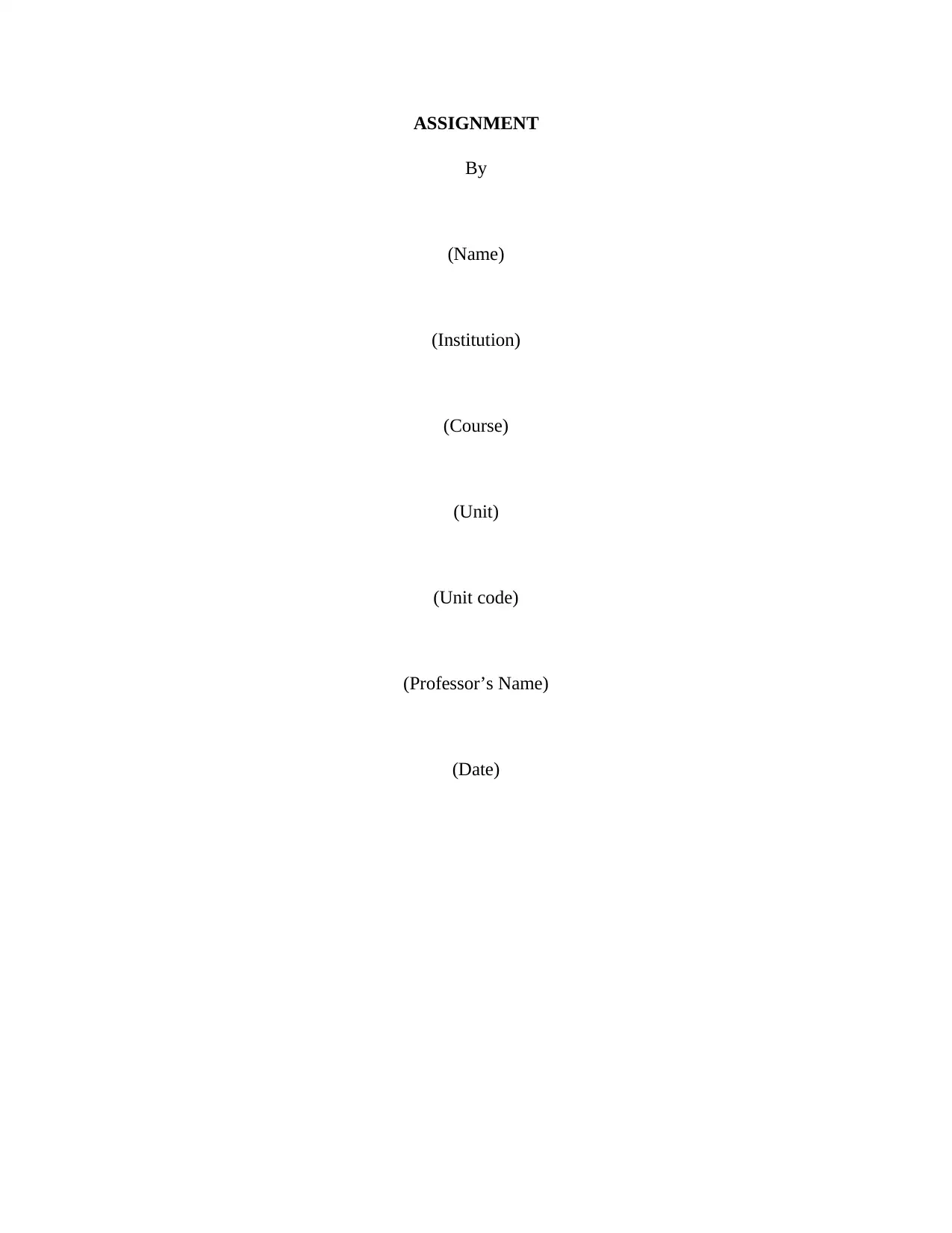
ASSIGNMENT
By
(Name)
(Institution)
(Course)
(Unit)
(Unit code)
(Professor’s Name)
(Date)
By
(Name)
(Institution)
(Course)
(Unit)
(Unit code)
(Professor’s Name)
(Date)
Paraphrase This Document
Need a fresh take? Get an instant paraphrase of this document with our AI Paraphraser

Solution
a) Velocity at exit (V)
Calculating the force exerted by the spring from Hooke’s law
F=Kx
K=5lb/ ft∧x=10∈¿ 10
12 ft
F= 5∗10
12 =4.167 lb
Calculating the acceleration of the ball
From the equation
F−mgsin 30=ma
4.167−0.33 sin 30=( 0.33
32.1 )a
a= 4.002∗32.1
0.33 =389.285 ft /s2
The component of ball weight normal to the tube does not work
The equation motion
a) Velocity at exit (V)
Calculating the force exerted by the spring from Hooke’s law
F=Kx
K=5lb/ ft∧x=10∈¿ 10
12 ft
F= 5∗10
12 =4.167 lb
Calculating the acceleration of the ball
From the equation
F−mgsin 30=ma
4.167−0.33 sin 30=( 0.33
32.1 )a
a= 4.002∗32.1
0.33 =389.285 ft /s2
The component of ball weight normal to the tube does not work
The equation motion

v2=u2 +2 a x
Where u=0, a=389.285 ft / s2 and x= 16
12 ft
Substituting the values
v2=(0)2 + 2∗389.285∗16
12 =1038.093 ( ft
s )
2
v= √1038.093=32.21 ft / s
The velocity at exit v= 32.21 ft / s
b) Time required to exit (t)
From the equation of motion
v=u+at
Making t the subject
t= v−u
a =32.21−0
389.285 =0.083 seconds
Time required t=0.083 seconds
Solution
Total length of the cable connecting block A and B
X A −2 Y B =0
Taking double differentiation to get the acceleration
V A −2V B=0
a A−2 aB=0
a A=2 aB∧aB =1
2 aA
FBD and kinetic diagram of Block A
Where u=0, a=389.285 ft / s2 and x= 16
12 ft
Substituting the values
v2=(0)2 + 2∗389.285∗16
12 =1038.093 ( ft
s )
2
v= √1038.093=32.21 ft / s
The velocity at exit v= 32.21 ft / s
b) Time required to exit (t)
From the equation of motion
v=u+at
Making t the subject
t= v−u
a =32.21−0
389.285 =0.083 seconds
Time required t=0.083 seconds
Solution
Total length of the cable connecting block A and B
X A −2 Y B =0
Taking double differentiation to get the acceleration
V A −2V B=0
a A−2 aB=0
a A=2 aB∧aB =1
2 aA
FBD and kinetic diagram of Block A
⊘ This is a preview!⊘
Do you want full access?
Subscribe today to unlock all pages.

Trusted by 1+ million students worldwide

At equilibrium of the inclined planes
T −W A sin 20−F=M A aB
T −200 sin 20−0.16∗200 cos 20= 200
32.2∗2 aB
T −38.334=12.42 aB Equation1
FBD and kinetic diagram of Block B
Equilibrium of inclined planes
W B sin7 0−2 T −F=MA aB
300 sin 70−2 T −0.25∗300 cos 70= 300
32.2 aB
128.12−T =4.658 aB Equation 2
Solving both equation 1 and 2
128.12−4.658 aB =38.334+12.42 aB
( 128.12−38.334 )=¿
aB=5.257 ft /s2
Acceleration of Block A
a A=2 aB
2∗5.257 ft
s2
a A=10.514 /s2
Part B
From equation 1
T −W A sin 20−F=M A aB
T −200 sin 20−0.16∗200 cos 20= 200
32.2∗2 aB
T −38.334=12.42 aB Equation1
FBD and kinetic diagram of Block B
Equilibrium of inclined planes
W B sin7 0−2 T −F=MA aB
300 sin 70−2 T −0.25∗300 cos 70= 300
32.2 aB
128.12−T =4.658 aB Equation 2
Solving both equation 1 and 2
128.12−4.658 aB =38.334+12.42 aB
( 128.12−38.334 )=¿
aB=5.257 ft /s2
Acceleration of Block A
a A=2 aB
2∗5.257 ft
s2
a A=10.514 /s2
Part B
From equation 1
Paraphrase This Document
Need a fresh take? Get an instant paraphrase of this document with our AI Paraphraser
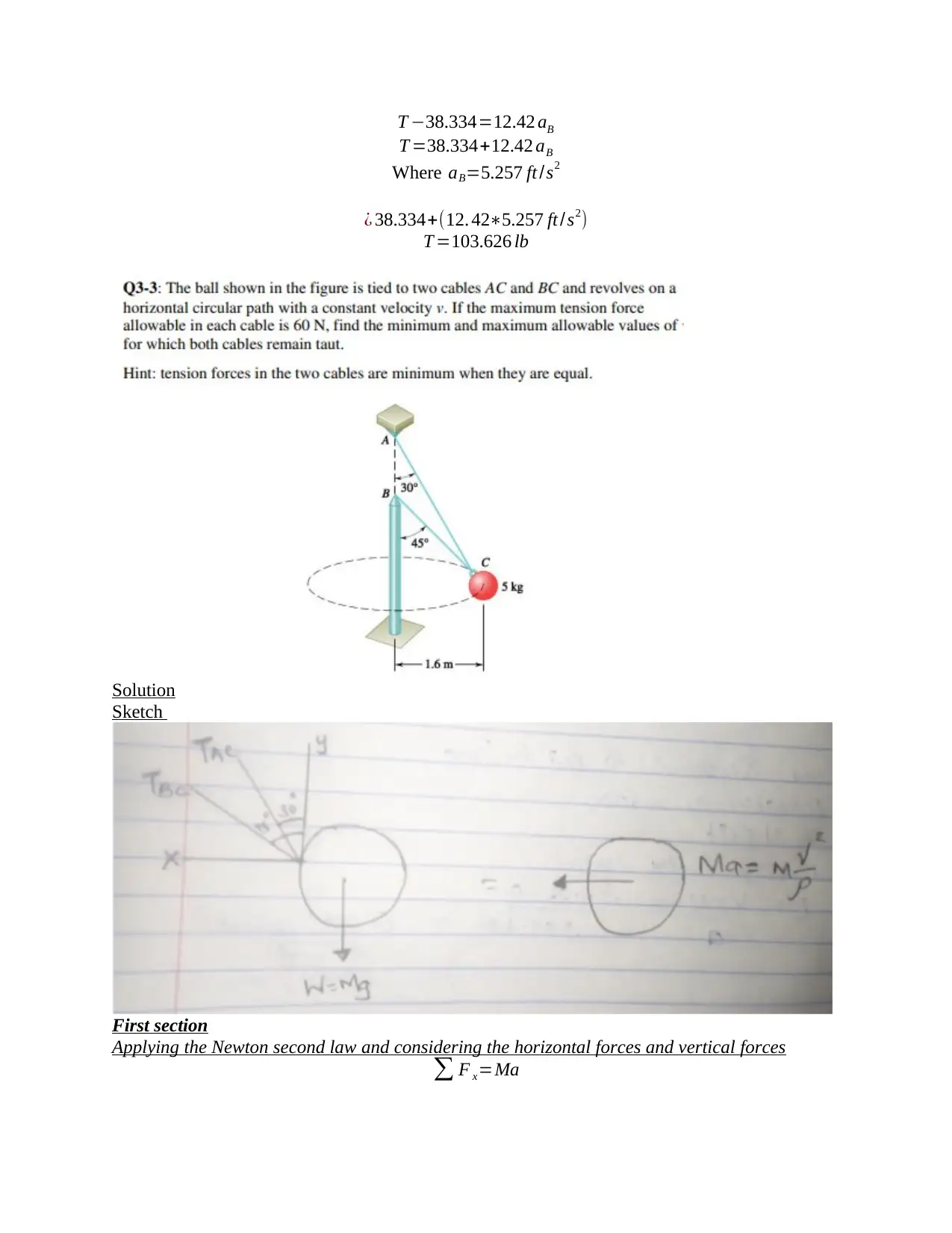
T −38.334=12.42 aB
T =38.334+12.42 aB
Where aB=5.257 ft /s2
¿ 38.334+(12. 42∗5.257 ft /s2)
T =103.626 lb
Solution
Sketch
First section
Applying the Newton second law and considering the horizontal forces and vertical forces
∑ F x=Ma
T =38.334+12.42 aB
Where aB=5.257 ft /s2
¿ 38.334+(12. 42∗5.257 ft /s2)
T =103.626 lb
Solution
Sketch
First section
Applying the Newton second law and considering the horizontal forces and vertical forces
∑ F x=Ma
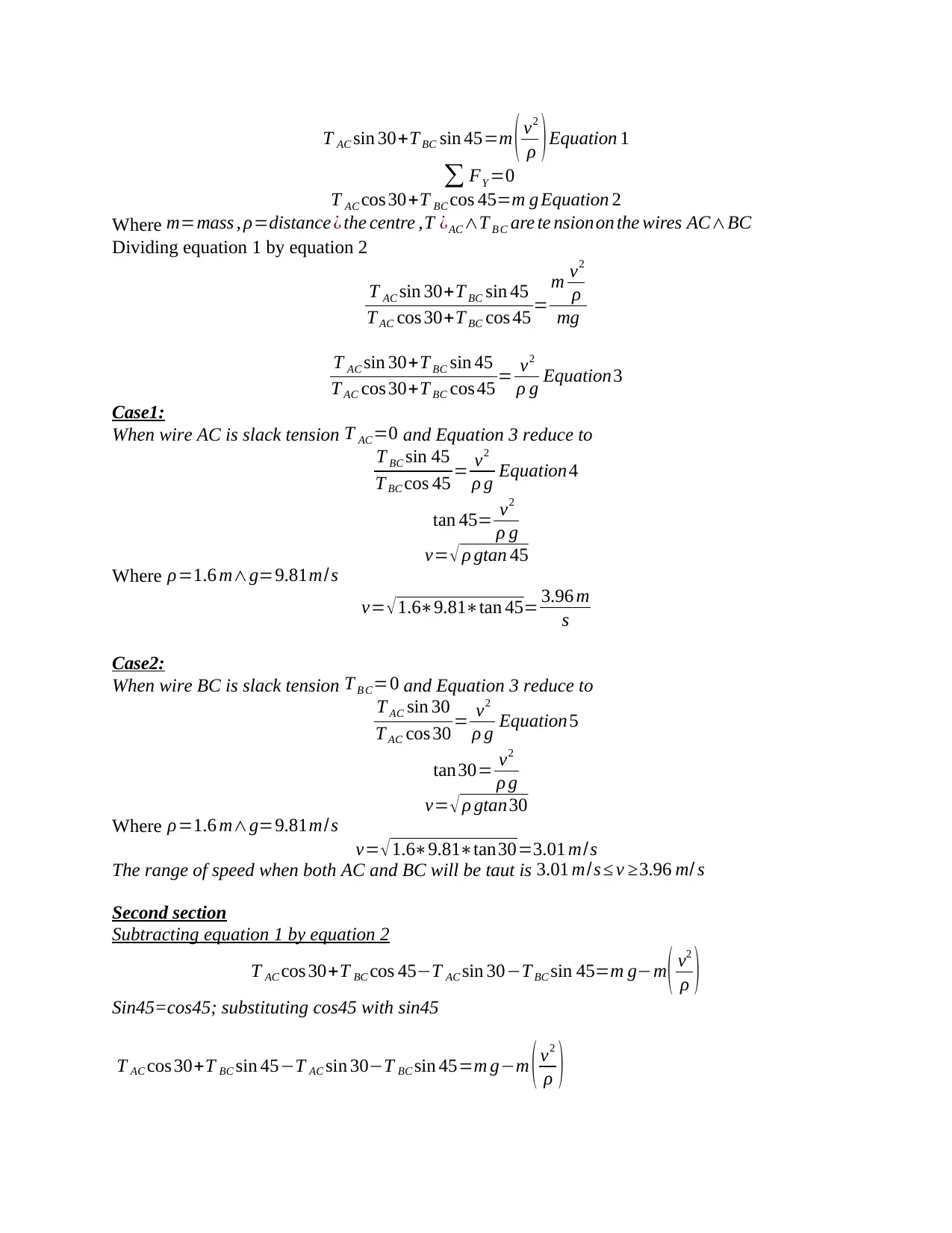
T AC sin 30+T BC sin 45=m ( v2
ρ ) Equation 1
∑ FY =0
T AC cos 30+T BC cos 45=m g Equation 2
Where m=mass , ρ=distance ¿ the centre ,T ¿AC∧T B C are te nsionon the wires AC∧BC
Dividing equation 1 by equation 2
T AC sin 30+T BC sin 45
T AC cos 30+T BC cos 45 =
m v2
ρ
mg
T AC sin 30+T BC sin 45
T AC cos 30+T BC cos 45 = v2
ρ g Equation3
Case1:
When wire AC is slack tension T AC=0 and Equation 3 reduce to
T BC sin 45
T BC cos 45 = v2
ρ g Equation4
tan 45= v2
ρ g
v= √ ρ gtan 45
Where ρ=1.6 m∧g=9.81m/s
v= √ 1.6∗9.81∗tan 45= 3.96 m
s
Case2:
When wire BC is slack tension T B C=0 and Equation 3 reduce to
T AC sin 30
T AC cos 30 = v2
ρ g Equation5
tan 30= v2
ρ g
v= √ ρ gtan30
Where ρ=1.6 m∧g=9.81m/s
v= √1.6∗9.81∗tan30=3.01 m/s
The range of speed when both AC and BC will be taut is 3.01 m/s ≤ v ≥3.96 m/ s
Second section
Subtracting equation 1 by equation 2
T AC cos 30+T BC cos 45−T AC sin 30−T BC sin 45=m g−m ( v2
ρ )
Sin45=cos45; substituting cos45 with sin45
T AC cos 30+T BC sin 45−T AC sin 30−T BC sin 45=m g−m ( v2
ρ )
ρ ) Equation 1
∑ FY =0
T AC cos 30+T BC cos 45=m g Equation 2
Where m=mass , ρ=distance ¿ the centre ,T ¿AC∧T B C are te nsionon the wires AC∧BC
Dividing equation 1 by equation 2
T AC sin 30+T BC sin 45
T AC cos 30+T BC cos 45 =
m v2
ρ
mg
T AC sin 30+T BC sin 45
T AC cos 30+T BC cos 45 = v2
ρ g Equation3
Case1:
When wire AC is slack tension T AC=0 and Equation 3 reduce to
T BC sin 45
T BC cos 45 = v2
ρ g Equation4
tan 45= v2
ρ g
v= √ ρ gtan 45
Where ρ=1.6 m∧g=9.81m/s
v= √ 1.6∗9.81∗tan 45= 3.96 m
s
Case2:
When wire BC is slack tension T B C=0 and Equation 3 reduce to
T AC sin 30
T AC cos 30 = v2
ρ g Equation5
tan 30= v2
ρ g
v= √ ρ gtan30
Where ρ=1.6 m∧g=9.81m/s
v= √1.6∗9.81∗tan30=3.01 m/s
The range of speed when both AC and BC will be taut is 3.01 m/s ≤ v ≥3.96 m/ s
Second section
Subtracting equation 1 by equation 2
T AC cos 30+T BC cos 45−T AC sin 30−T BC sin 45=m g−m ( v2
ρ )
Sin45=cos45; substituting cos45 with sin45
T AC cos 30+T BC sin 45−T AC sin 30−T BC sin 45=m g−m ( v2
ρ )
⊘ This is a preview!⊘
Do you want full access?
Subscribe today to unlock all pages.

Trusted by 1+ million students worldwide
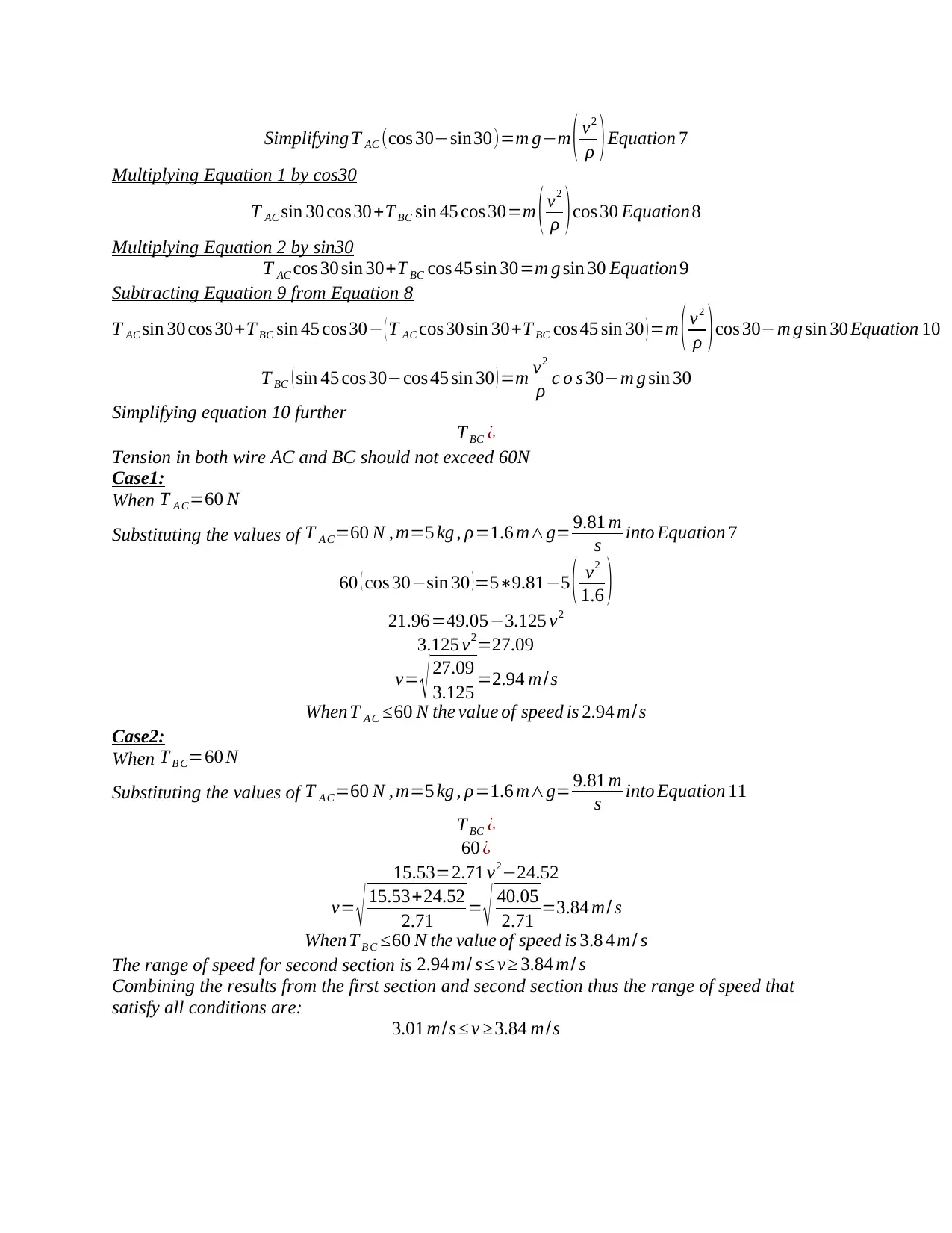
SimplifyingT AC (cos 30−sin30)=m g−m ( v2
ρ )Equation 7
Multiplying Equation 1 by cos30
T AC sin 30 cos 30+T BC sin 45 cos 30=m ( v2
ρ ) cos 30 Equation8
Multiplying Equation 2 by sin30
T AC cos 30 sin 30+T BC cos 45 sin 30=m g sin 30 Equation9
Subtracting Equation 9 from Equation 8
T AC sin 30 cos 30+T BC sin 45 cos 30− ( T AC cos 30 sin 30+T BC cos 45 sin 30 ) =m ( v2
ρ ) cos 30−m g sin 30 Equation 10
T BC ( sin 45 cos 30−cos 45 sin 30 ) =m v2
ρ c o s 30−m g sin 30
Simplifying equation 10 further
T BC ¿
Tension in both wire AC and BC should not exceed 60N
Case1:
When T A C=60 N
Substituting the values of T A C=60 N , m=5 kg , ρ=1.6 m∧g= 9.81 m
s into Equation 7
60 ( cos 30−sin 30 )=5∗9.81−5 ( v2
1.6 )
21.96=49.05−3.125 v2
3.125 v2=27.09
v= √ 27.09
3.125 =2.94 m/s
When T A C ≤60 N the value of speed is 2.94 m/s
Case2:
When T B C=60 N
Substituting the values of T A C=60 N , m=5 kg , ρ=1.6 m∧g= 9.81 m
s into Equation 11
T BC ¿
60 ¿
15.53=2.71 v2−24.52
v= √ 15.53+24.52
2.71 = √ 40.05
2.71 =3.84 m/ s
When T B C ≤60 N the value of speed is 3.8 4 m/ s
The range of speed for second section is 2.94 m/ s ≤ v ≥ 3.84 m/ s
Combining the results from the first section and second section thus the range of speed that
satisfy all conditions are:
3.01 m/s ≤ v ≥3.84 m/s
ρ )Equation 7
Multiplying Equation 1 by cos30
T AC sin 30 cos 30+T BC sin 45 cos 30=m ( v2
ρ ) cos 30 Equation8
Multiplying Equation 2 by sin30
T AC cos 30 sin 30+T BC cos 45 sin 30=m g sin 30 Equation9
Subtracting Equation 9 from Equation 8
T AC sin 30 cos 30+T BC sin 45 cos 30− ( T AC cos 30 sin 30+T BC cos 45 sin 30 ) =m ( v2
ρ ) cos 30−m g sin 30 Equation 10
T BC ( sin 45 cos 30−cos 45 sin 30 ) =m v2
ρ c o s 30−m g sin 30
Simplifying equation 10 further
T BC ¿
Tension in both wire AC and BC should not exceed 60N
Case1:
When T A C=60 N
Substituting the values of T A C=60 N , m=5 kg , ρ=1.6 m∧g= 9.81 m
s into Equation 7
60 ( cos 30−sin 30 )=5∗9.81−5 ( v2
1.6 )
21.96=49.05−3.125 v2
3.125 v2=27.09
v= √ 27.09
3.125 =2.94 m/s
When T A C ≤60 N the value of speed is 2.94 m/s
Case2:
When T B C=60 N
Substituting the values of T A C=60 N , m=5 kg , ρ=1.6 m∧g= 9.81 m
s into Equation 11
T BC ¿
60 ¿
15.53=2.71 v2−24.52
v= √ 15.53+24.52
2.71 = √ 40.05
2.71 =3.84 m/ s
When T B C ≤60 N the value of speed is 3.8 4 m/ s
The range of speed for second section is 2.94 m/ s ≤ v ≥ 3.84 m/ s
Combining the results from the first section and second section thus the range of speed that
satisfy all conditions are:
3.01 m/s ≤ v ≥3.84 m/s
Paraphrase This Document
Need a fresh take? Get an instant paraphrase of this document with our AI Paraphraser
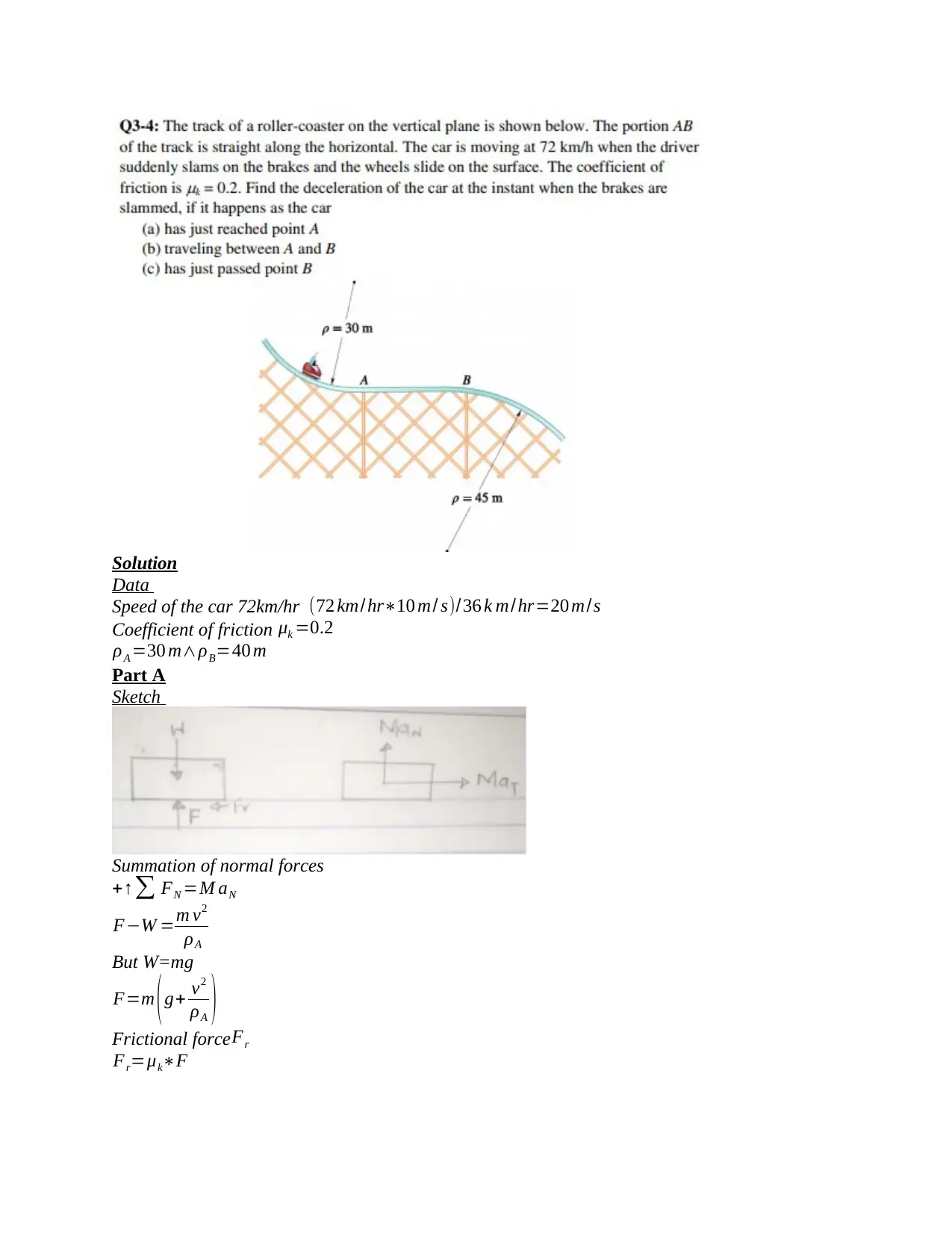
Solution
Data
Speed of the car 72km/hr (72 km/hr∗10 m/ s)/36 k m/hr=20 m/s
Coefficient of friction μk =0.2
ρA =30 m∧ρB=40 m
Part A
Sketch
Summation of normal forces
+↑∑ FN =M aN
F−W =m v2
ρA
But W=mg
F=m ( g+ v2
ρA )
Frictional forceFr
Fr=μk∗F
Data
Speed of the car 72km/hr (72 km/hr∗10 m/ s)/36 k m/hr=20 m/s
Coefficient of friction μk =0.2
ρA =30 m∧ρB=40 m
Part A
Sketch
Summation of normal forces
+↑∑ FN =M aN
F−W =m v2
ρA
But W=mg
F=m ( g+ v2
ρA )
Frictional forceFr
Fr=μk∗F
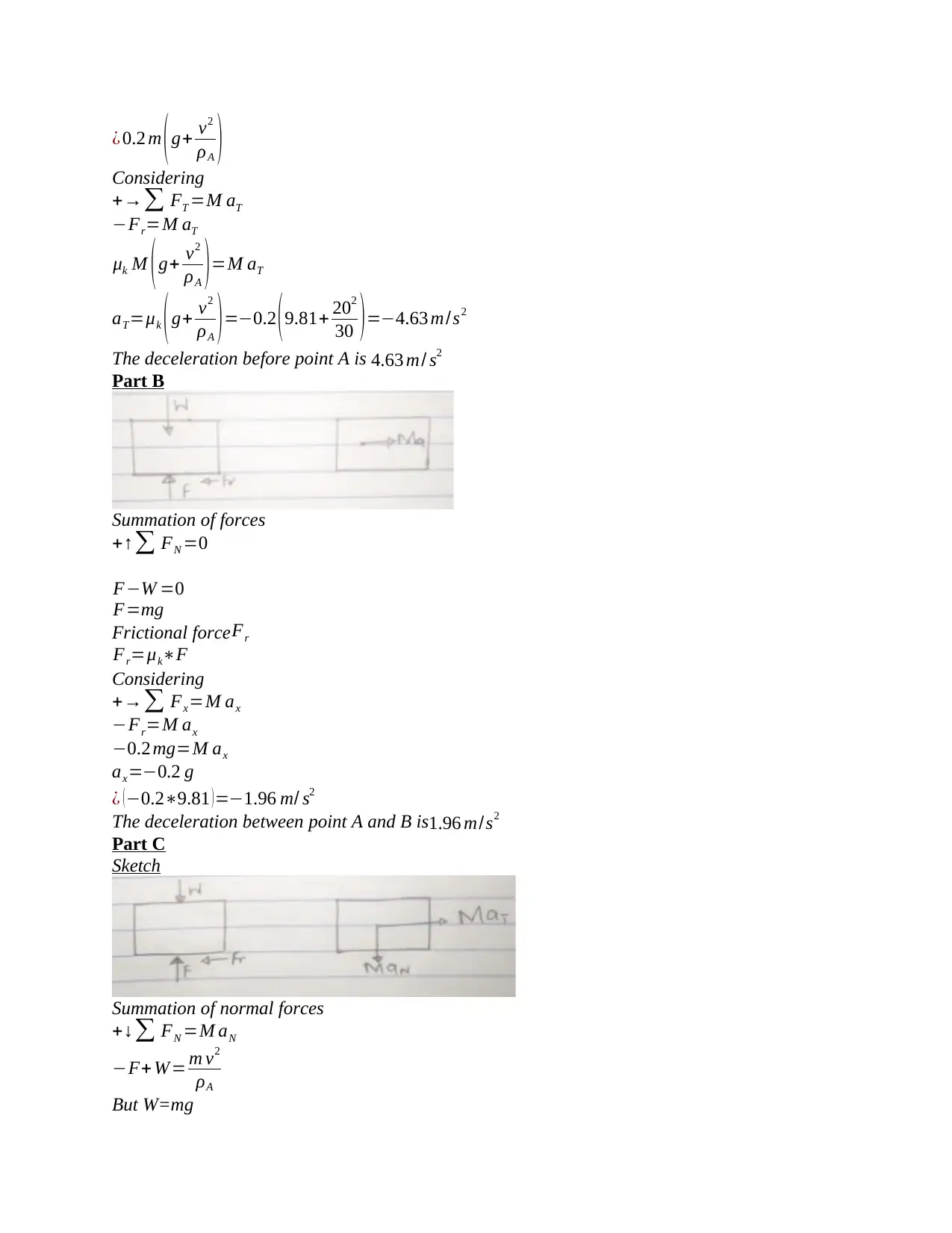
¿ 0.2 m (g+ v2
ρA )
Considering
+→∑ FT =M aT
−Fr=M aT
μk M (g+ v2
ρA )=M aT
aT=μk ( g+ v2
ρA ) =−0.2 ( 9.81+ 202
30 ) =−4.63 m/s2
The deceleration before point A is 4.63 m/ s2
Part B
Summation of forces
+↑∑ FN =0
F−W =0
F=mg
Frictional forceFr
Fr=μk∗F
Considering
+→∑ Fx=M ax
−Fr=M ax
−0.2 mg=M ax
ax=−0.2 g
¿ ( −0.2∗9.81 ) =−1.96 m/ s2
The deceleration between point A and B is1.96 m/s2
Part C
Sketch
Summation of normal forces
+↓∑ FN =M aN
−F+ W= m v2
ρA
But W=mg
ρA )
Considering
+→∑ FT =M aT
−Fr=M aT
μk M (g+ v2
ρA )=M aT
aT=μk ( g+ v2
ρA ) =−0.2 ( 9.81+ 202
30 ) =−4.63 m/s2
The deceleration before point A is 4.63 m/ s2
Part B
Summation of forces
+↑∑ FN =0
F−W =0
F=mg
Frictional forceFr
Fr=μk∗F
Considering
+→∑ Fx=M ax
−Fr=M ax
−0.2 mg=M ax
ax=−0.2 g
¿ ( −0.2∗9.81 ) =−1.96 m/ s2
The deceleration between point A and B is1.96 m/s2
Part C
Sketch
Summation of normal forces
+↓∑ FN =M aN
−F+ W= m v2
ρA
But W=mg
⊘ This is a preview!⊘
Do you want full access?
Subscribe today to unlock all pages.

Trusted by 1+ million students worldwide

F=m (g− v2
ρB )
Frictional force Fr
Fr=μk∗F
¿ 0.2 m ( g− v2
ρA )
Considering
+→∑ FT =M aT
−Fr=M aT
−μk M ( g− v2
ρA )=M aT
aT=−μk (g− v2
ρA )=−0.2 (9.81− 202
30 )=−0.184 m/s2
The deceleration after point B is 0.184 m/ s2
Solution
ρB )
Frictional force Fr
Fr=μk∗F
¿ 0.2 m ( g− v2
ρA )
Considering
+→∑ FT =M aT
−Fr=M aT
−μk M ( g− v2
ρA )=M aT
aT=−μk (g− v2
ρA )=−0.2 (9.81− 202
30 )=−0.184 m/s2
The deceleration after point B is 0.184 m/ s2
Solution
Paraphrase This Document
Need a fresh take? Get an instant paraphrase of this document with our AI Paraphraser
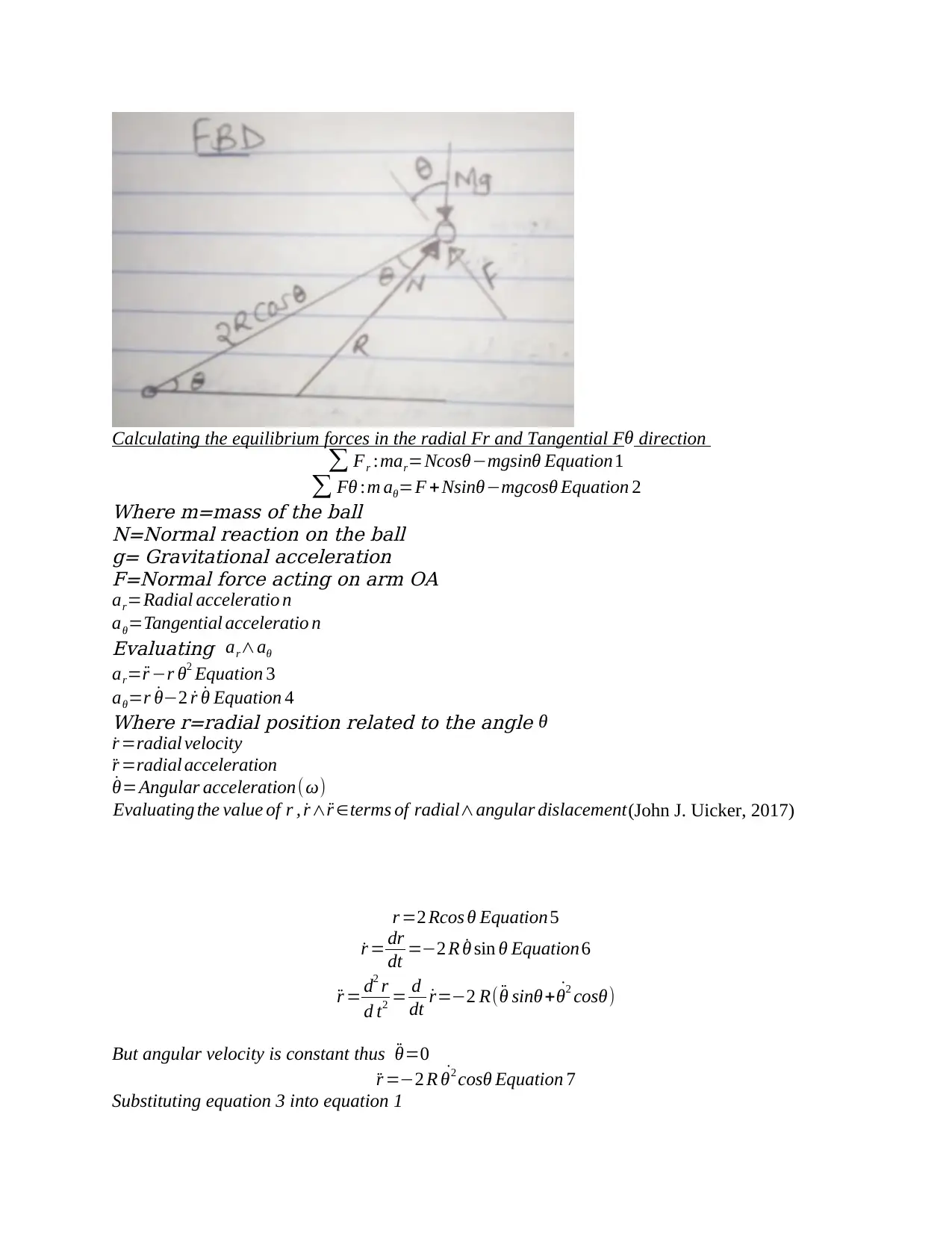
Calculating the equilibrium forces in the radial Fr and Tangential F θ direction
∑ Fr :mar=Ncosθ−mgsinθ Equation1
∑ Fθ :m aθ=F +Nsinθ−mgcosθ Equation 2Where m=mass of the ball
N=Normal reaction on the ball
g= Gravitational acceleration
F=Normal force acting on arm OA
ar=Radial acceleratio n
aθ=Tangential acceleratio nEvaluating ar∧aθ
ar= ¨r −r θ2 Equation 3
aθ=r ˙θ−2 ˙r ˙θ Equation 4Where r=radial position related to the angle θ
˙r =radial velocity
¨r =radial acceleration
˙θ=Angular acceleration(ω)
Evaluating the value of r , ˙r∧ ¨r ∈terms of radial∧angular dislacement(John J. Uicker, 2017)
r =2 Rcos θ Equation5
˙r = dr
dt =−2 R ˙θ sin θ Equation6
¨r = d2 r
d t2 = d
dt ˙r=−2 R( ¨θ sinθ + ˙θ2 cosθ)
But angular velocity is constant thus ¨θ=0
¨r =−2 R ˙θ2 cosθ Equation 7
Substituting equation 3 into equation 1
∑ Fr :mar=Ncosθ−mgsinθ Equation1
∑ Fθ :m aθ=F +Nsinθ−mgcosθ Equation 2Where m=mass of the ball
N=Normal reaction on the ball
g= Gravitational acceleration
F=Normal force acting on arm OA
ar=Radial acceleratio n
aθ=Tangential acceleratio nEvaluating ar∧aθ
ar= ¨r −r θ2 Equation 3
aθ=r ˙θ−2 ˙r ˙θ Equation 4Where r=radial position related to the angle θ
˙r =radial velocity
¨r =radial acceleration
˙θ=Angular acceleration(ω)
Evaluating the value of r , ˙r∧ ¨r ∈terms of radial∧angular dislacement(John J. Uicker, 2017)
r =2 Rcos θ Equation5
˙r = dr
dt =−2 R ˙θ sin θ Equation6
¨r = d2 r
d t2 = d
dt ˙r=−2 R( ¨θ sinθ + ˙θ2 cosθ)
But angular velocity is constant thus ¨θ=0
¨r =−2 R ˙θ2 cosθ Equation 7
Substituting equation 3 into equation 1
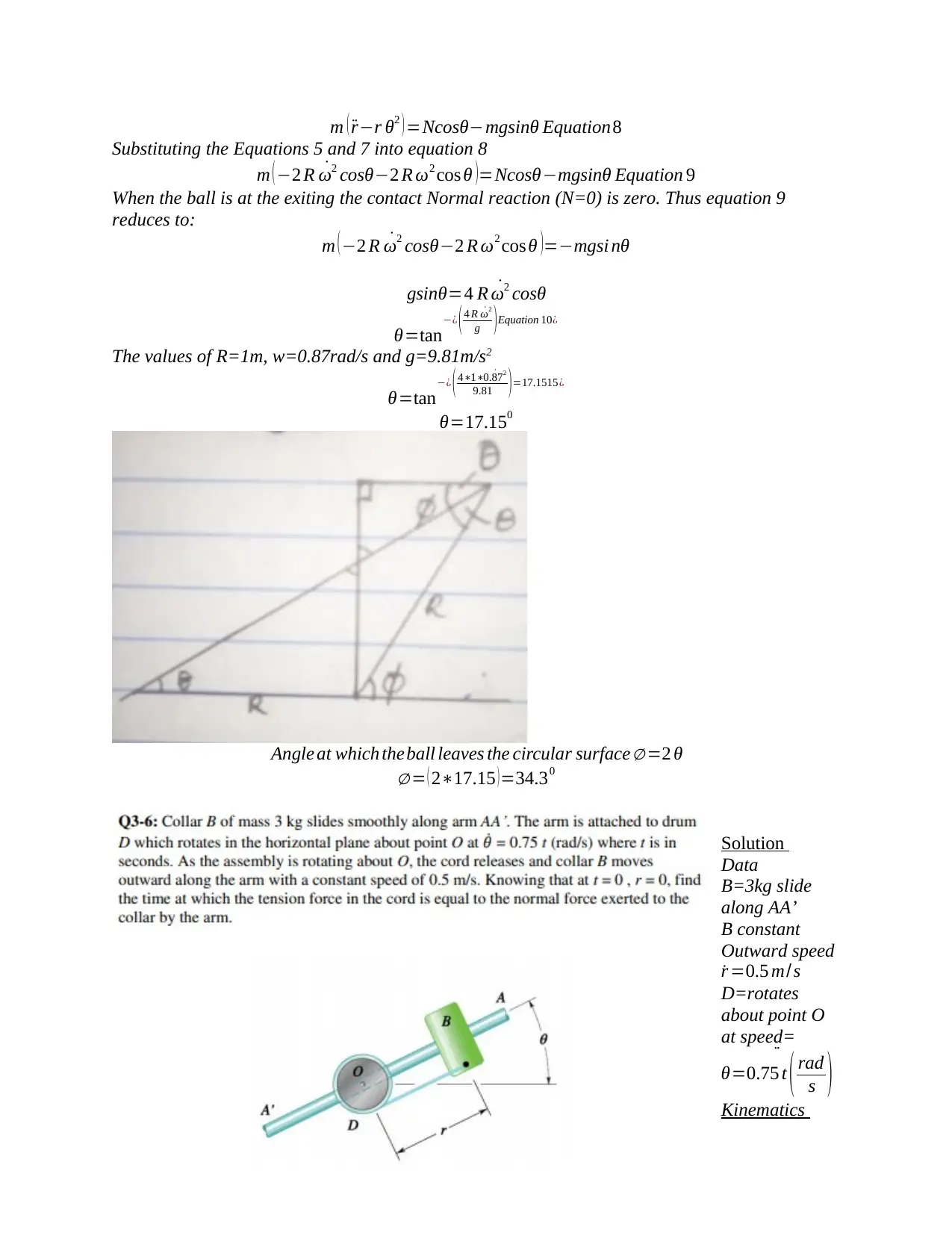
m ( ¨r−r θ2 ) =Ncosθ−mgsinθ Equation8
Substituting the Equations 5 and 7 into equation 8
m (−2 R ˙ω2 cosθ−2 R ω2 cos θ )=Ncosθ−mgsinθ Equation 9
When the ball is at the exiting the contact Normal reaction (N=0) is zero. Thus equation 9
reduces to:
m ( −2 R ˙ω2 cosθ−2 R ω2 cos θ )=−mgsi nθ
gsinθ=4 R ˙ω2 cosθ
θ=tan−¿ ( 4 R ˙ω2
g )Equation 10¿
The values of R=1m, w=0.87rad/s and g=9.81m/s2
θ=tan−¿ ( 4∗1∗ ˙0.872
9.81 )=17.1515¿
θ=17.150
Angle at which theball leaves the circular surface ∅ =2 θ
∅ = ( 2∗17.15 ) =34.30
Solution
Data
B=3kg slide
along AA’
B constant
Outward speed
˙r =0.5 m/s
D=rotates
about point O
at speed=
¨
θ=0.75 t ( rad
s )
Kinematics
Substituting the Equations 5 and 7 into equation 8
m (−2 R ˙ω2 cosθ−2 R ω2 cos θ )=Ncosθ−mgsinθ Equation 9
When the ball is at the exiting the contact Normal reaction (N=0) is zero. Thus equation 9
reduces to:
m ( −2 R ˙ω2 cosθ−2 R ω2 cos θ )=−mgsi nθ
gsinθ=4 R ˙ω2 cosθ
θ=tan−¿ ( 4 R ˙ω2
g )Equation 10¿
The values of R=1m, w=0.87rad/s and g=9.81m/s2
θ=tan−¿ ( 4∗1∗ ˙0.872
9.81 )=17.1515¿
θ=17.150
Angle at which theball leaves the circular surface ∅ =2 θ
∅ = ( 2∗17.15 ) =34.30
Solution
Data
B=3kg slide
along AA’
B constant
Outward speed
˙r =0.5 m/s
D=rotates
about point O
at speed=
¨
θ=0.75 t ( rad
s )
Kinematics
⊘ This is a preview!⊘
Do you want full access?
Subscribe today to unlock all pages.

Trusted by 1+ million students worldwide
1 out of 15
Your All-in-One AI-Powered Toolkit for Academic Success.
+13062052269
info@desklib.com
Available 24*7 on WhatsApp / Email
![[object Object]](/_next/static/media/star-bottom.7253800d.svg)
Unlock your academic potential
Copyright © 2020–2025 A2Z Services. All Rights Reserved. Developed and managed by ZUCOL.